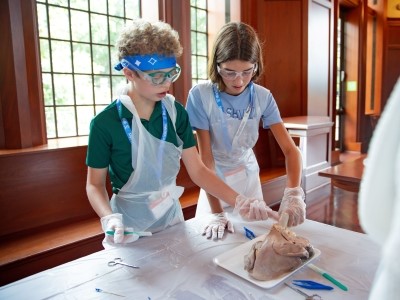NYLF Explore STEM: Program Highlights
Keynote Speakers
 This program provides an unprecedented opportunity for students to hear from experts in various STEM fields, including engineers, medical and forensic science professionals, or former NASA astronauts*. These speakers will share their knowledge, experiences, and stories from their careers to provide students with insights and inspiration. Past speakers include:
This program provides an unprecedented opportunity for students to hear from experts in various STEM fields, including engineers, medical and forensic science professionals, or former NASA astronauts*. These speakers will share their knowledge, experiences, and stories from their careers to provide students with insights and inspiration. Past speakers include:
- Dr. Jennifer C. Munoz Pareja - A leader in pediatric critical care who focuses on understanding and treating pediatric acute brain injuries in collaboration with The Miami Project to Cure Paralysis
- Rebecca Cooper Jackson, CLPE - Works as a Certified Latent Print Examiner at the Atlanta Police Department Crime Lab—this prestigious title is shared by fewer than 1,000 individuals nationwide.
- Leroy Chiao, Ph.D. - Chemical Engineer and retired NASA astronaut who logged 229 days in space on four missions, including commanding the International Space Station and completing six spacewalks
*Students will hear from former NASA astronauts in Berkeley, CA; Houston, TX; and New York, NY.
Forensic Science Simulation
 During this simulation, students will process a staged crime scene using proper techniques, including note-taking, evidence collections, and constructing a scene sketch. Students will also identify, collect, and examine fingerprints and shoe tracks, and will perform bloodstain pattern analysis and conduct tests on mock bloodstains.
During this simulation, students will process a staged crime scene using proper techniques, including note-taking, evidence collections, and constructing a scene sketch. Students will also identify, collect, and examine fingerprints and shoe tracks, and will perform bloodstain pattern analysis and conduct tests on mock bloodstains.
Engineering Design Simulation

During this innovative simulation, students will test their civil engineering skills as they use CAD software to design a new environment. Students will receive an interactive introduction to CAD software and then work through the design process.
Robotics Programming Simulation

During this simulation, students will design and program a robot, using the latest tools, theories, and techniques. After learning about the technology involved in creating a programmable robot, students will explore what makes a robot intelligent and how sensors support intelligent technology. Students will also learn how to code a robot capable of moving with precision, avoiding obstacles, and acting upon command.
Medical Simulation
Students learn how to respond to unexpected medical emergencies while participating in:
Dissection Lab
Students will learn about anatomy through dissections and research to identify different parts of the lungs-the two chambers, the pulmonary artery, and the trachea.
Emergency Outdoor Medicine Simulation: When Care Is Hours Away

Created by the late wilderness medicine expert Dr. Paul Auerbach and simulation expert Dr. Rebecca Smith-Coggins while professors in the Department of Emergency Medicine of the Stanford University School of Medicine, this realistic simulation puts students in the position of first responders as they practice the clinical skills needed in a true-to-life emergency. They’ll experience an unexpected crisis that involves prolonged patient care, a severe environment, and improvised equipment as they learn and practice six key skills:
- Scene assessment and safety
- Spine precautions
- Commercial and improvised tourniquets
- Hypothermia prevention
- Fracture splinting
- Treatment of life-threatening allergic reactions